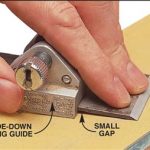We may receive a commission when you use our affiliate links. However, this does not impact our recommendations.
Are you a tails or pins first kind of woodworker? If you want to start the woodworker’s equivalent of a bar fight, simply blurt out in a crowd of woodworkers that the best way to cut dovetails is pins first. A tails first declaration works equally well to get the fight started. The truth is, either way is best if it’s the way that works for you.
In The Dough Box–Part 3 of 4 I am going to show you how to model dovetail joinery in splayed sides and ends. Which you model first doesn’t really matter. I am a tails first guy in the shop and a pins first guy in SketchUp. What really matters in this segment is that we can’t use the Push/Pull tool, which normally is the workhorse of modeling dovetails.
Why can’t we use the Push/Pull tool you ask? Well it’s a combination of the way the Push/Pull tool works and the angle between faces we encounter in splayed sides and ends. When you select a Face with the Push/Pull tool and extrude it, what happens behind the scenes is that SketchUp calculates a vector (a direction to go) that is normal (perpendicular) to the face you selected. Then it moves the face in that direction, creating lines and faces to connect to the original face to form a 3D model as it goes. This works great for right angle and rectilinear models or components. But when a side is splayed and the side’s ends are a compound angle – well, good luck.
But hey, the reason we build complex furniture in the shop is so we can impress our family and friends. We are happy to pay the price of extra physical and mental work to do so. SketchUp is no different. We model complex furniture to impress; and yes to create shop drawing from which to build complex furniture to impress yet again. So let’s get started. Roll the projector.
Here are some supplies and tools we find essential in our everyday work around the shop. We may receive a commission from sales referred by our links; however, we have carefully selected these products for their usefulness and quality.








